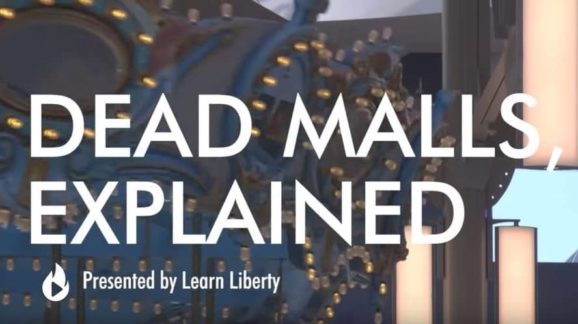Economic Planning and Dead Mall Legends

The kind of American chain stores and retail formats that dominated the second half of the 20th century have fallen on hard times in the 21st, and commentary on this influential and dislocating trend has become a cottage industry unto itself. Amid coverage in the business press on topics like “the winners and losers of the retail apocalypse” and how “1 in 3 American malls are doomed,” there is even a vibrant and, to many, inexplicable cultural fascination with retail history and dead malls.
Our friends at Learn Liberty recently weighed in on the debate with a video titled “Dead Malls, Explained.” I like the idea that some YouTube viewers might have stumbled on it because of their interest in urban spelunking videos rather than economics, and I think it gets a lot of things (though not everything) right.
The question of how the United States ended up with so many large, enclosed suburban shopping centers built between 1960 and 2000 is an interesting one. Naturally, trends in urban planning and government housing policy played a role. We wouldn’t have had as many suburban malls—or as many suburbs—without the interstate highway system. There were also, as the video points out, a lot of World War II veterans who were eligible for G.I. Bill benefits like federally guaranteed mortgage loans who ended up buying homes in those suburbs and eventually shopping at those malls.
Many localities, moreover, were eager to attract new business investment, and offered new mall developers special benefit packages that included things like changes to zoning rules, property tax abatements, and promises to spend additional taxpayer money on road and utility infrastructure. The same is true today. All of these things were conscious choices made by elected leaders and municipal civil servants, not market forces. Those decisions drove the expansion of suburban development and of big enclosed shopping centers.
The conclusion that this argument is leading to will be clear to people familiar with the free-market line of thought. Government policy that artificially privileged a certain type of economic development led to overinvestment in the privileged category and eventually led to the dead mall retail bust we see today. We would probably have seen fewer small town Main Streets wither away if not for these unfair policies and fewer shopping centers going bust, many years later, all at once.
That analysis is generally sound, but I would caution viewers not to go too far in the direction of “all of this is artificial.” Suburban development received an indirect subsidy from postwar government spending on transportation infrastructure, but the motive for that wasn’t a shadowy cabal of planners. Suburban development was extremely popular with actual living, breathing, and voting Americans. Single family houses on their own plots of land, driving one’s own car, and being able to live separately from commercial centers (whether downtowns or shopping malls) was a lifestyle many millions of Americans enjoyed and aspired to.
That’s not a defense of the many instances of actual cronyism that played out in the late 20th century American retail space, but it is a caution against embracing paranoid assumptions about long-term societal trends. There’s a tendency among some people to think that any trend they don’t like must be unpopular in general, and that the only explanation for widely unpopular things happening is a secret, anti-democratic force pushing us all in the wrong direction. Mass transit fanatics have their “General Motors killed the trolley cars” (i.e., Who Framed Roger Rabbit?) theories and high-density urbanists have a tendency to think that suburbia was always considered an unappealing wasteland that had to be foisted on Americans against their will. But just because it’s not your cup of tea doesn’t mean that it wasn’t popular with plenty of other people.
We should be careful about projecting our preferences onto our fellow Americans—doubly so Americans who lived and worked in places we’ve never visited or who were living decades before we were born. When I was a kid in the 1980s and a teenager in the 1990s, the cognoscenti were united in the opinion that suburban shopping malls were the absolute nadir of modern society, an example of everything boring and reactionary about America. Culture-critic hipsters, horrified by this manifestation of revolting consumerism, theorized that no one could have wanted to see such development happen. Surely it was a conspiracy against good taste.
But as it turns out, culture-critic hipsters tend to be poor judges of what most Americans actually want and enjoy. Urban sophisticates of the 1980s may have been disgusted at the thought of spending their Saturday at a mall, but their absence only made more room for the hordes of Americans who were more than happy to make their local mall their second home and “third place.” Cartoonist Peter Bagge captured this tension with this excellent four-page distillation, originally published in Reason in 2002.